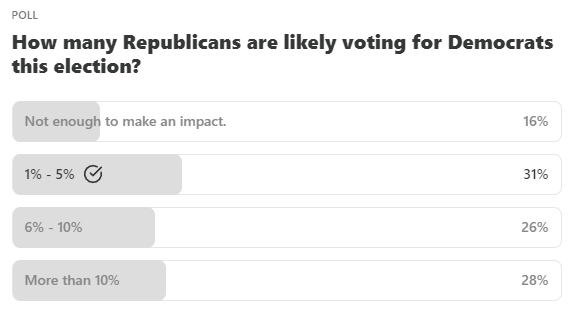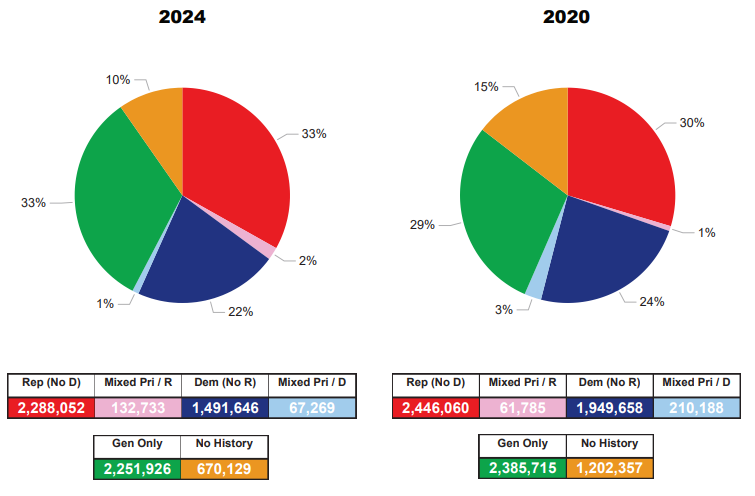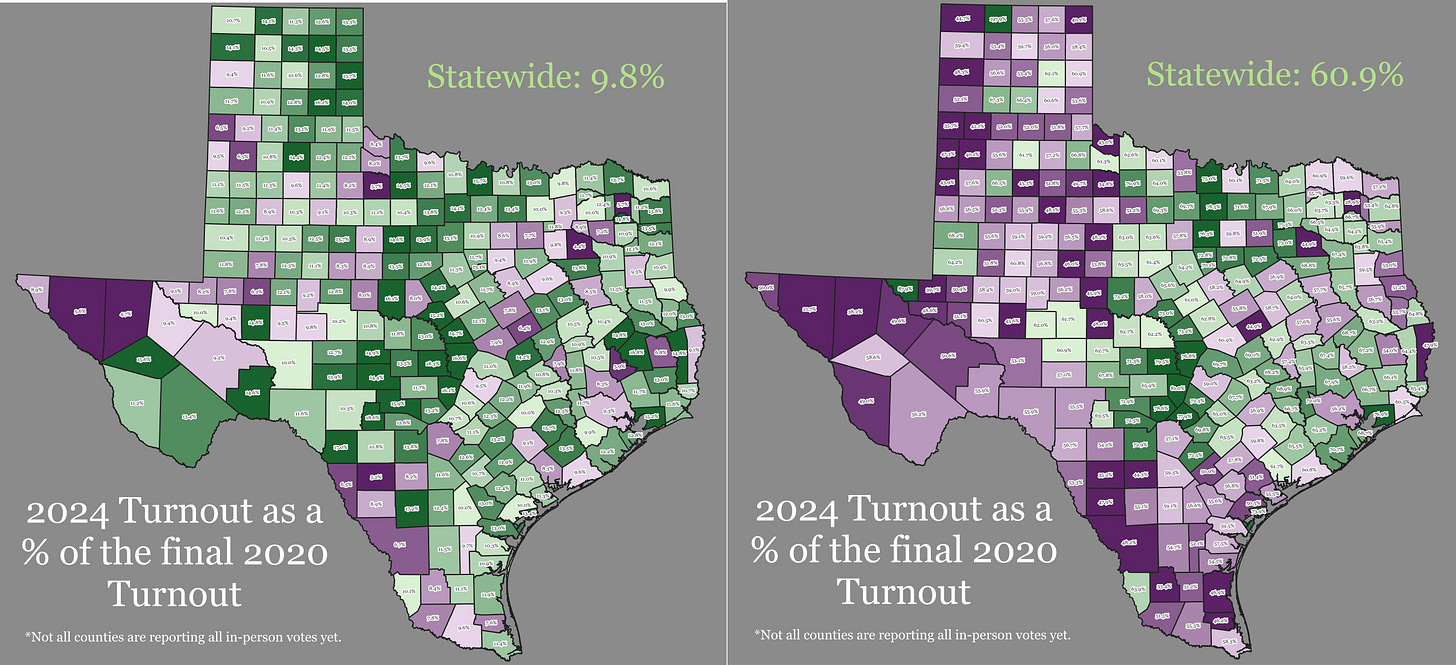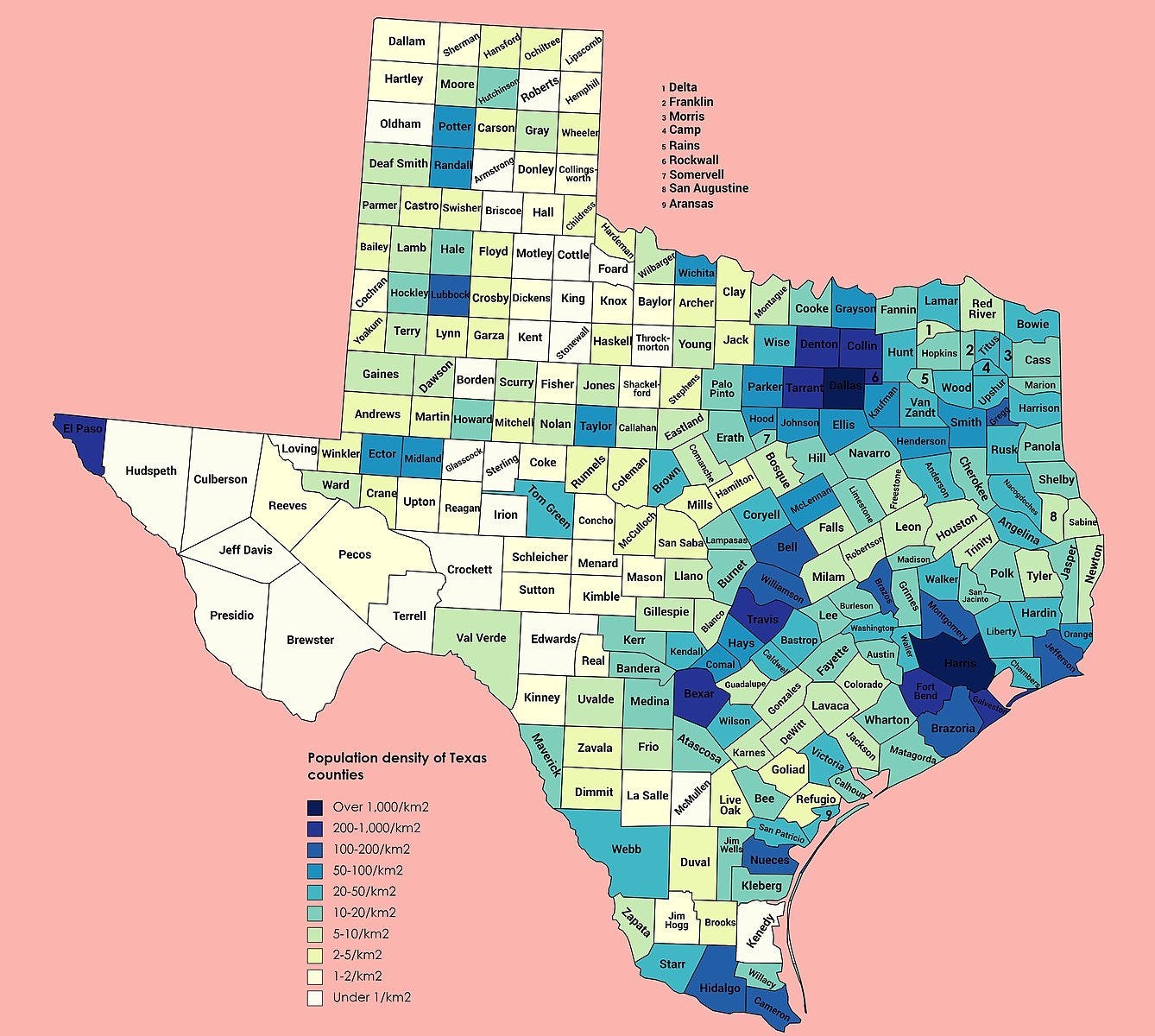Texas Day 9 Voting Breakdown: Urban Counties Key To Progressive Victory
A close race and historic turnout as Texas voters hold the power of change.
Yesterday, our favorite Texas progressive Congressman, Greg Casar, appeared on Hasan Piker’s Twitch stream. In their discussion, Casar and Piker cover how GOP policies on guns, immigration, and public health inadvertently aid cartels and exploit economic and cultural insecurities, with Republicans often scapegoating marginalized groups. Casar argued that Democrats must push a populist message focused on economic justice and corporate accountability, especially in Texas, where Latino voter engagement could reshape the state’s politics. He stresses that Democrats should not shy away from progressive stances and urges voter participation to drive meaningful change.
It’s worth the watch (32 minutes).
There’s a much larger conversation to be had here, and we’ll delve into it after the election. Progressivism is rising in Texas, but not many people outside of Texas progressives seem to realize it.
Clayton Tucker, the president of the Texas Progressive Caucus, constantly reminds us that the Progressive Movement’s roots sprouted in Texas well over 100 years ago. Check out what he wrote about it:
A few weeks ago, while meeting with several grassroots organizers in North Texas, a conversation about the rise of progressive ideology among Texas Democrats came up. It isn’t just Clayton and me saying this. Organizers are embracing Texas, not just becoming a blue state but becoming a progressive state. The conversation turned to the broader implications of policy and how a blue, progressive Texas could impact policy in DC.
As bad as Texas Democrats have had in recent years, there’s a light at the end of the tunnel, and it isn’t a train. We will move the needle in this coming election, just like we’ve moved it in every other election in the last decade. Whether we give Harris and Allred a win next week remains to be seen, but no matter what happens, we know we’re headed in the right direction and one day will be able to end the GOP fascist rule over the Lone Star State. And perhaps strong progressive messaging will get us there.
Day 9 early voting numbers.
Texas saw another fantastic early voting day, with over 650K voters casting a ballot. This puts us, so far, at:
6,893,653 total Texans have cast their vote
Or, 37.02% of registered voters.
The right and the left have been endlessly scrutinizing the early voting numbers. What do they mean? What county did they vote in? What are their demographics? Have they voted in primary elections before? Which ones?
At this point, it’s all just one big guessing game. I’m proud that Texans are doing their civic duty and going to the polls. Texas is in the 51st place regarding voter turnout (all states + DC). Maybe this will be the year we change that. Perhaps we’ll drop to #49 or #47—as long as we improve from where we were.
Republican Ryan Data put out an early voting update today with the numbers through Day 9. While he seems optimistic about Republican turnout, I think there’s a bigger picture to it. (The following data/graphs are from Ryan Data.)
He’s showing the breakdown of early voters based on their previous election history. His methodology shows that 33% of the voters who already cast a vote have previously voted only in Republican primaries, and 22% previously voted in Democratic primaries.
That’s only 55% of early voters. The other 45% are wildcards. However, when one digs deeper into his methodology, two things should be noted.
How many Texas Democrats, especially in rural areas, vote in the Republican primaries because there aren’t Democrats on the ballot in their local races, and they want the lesser of two evils? Republicans have been adamant about closing our primary systems for this very reason. In Dade Phelan’s primary race earlier this year, Republican data analysts estimated that 9% of Phelan’s votes came from Democrats (if you trust Republican data).
How many “crossover” votes will we see in this strange and abnormal election? I asked y’all that the other day and 54% of you think it’ll be more than 5%.
(If you missed a chance to vote, the poll is still up for one more day.)
Further, Ryan Data’s comparison between 2024 and 2020 shows that the number of voters who vote in Republican primaries isn’t far off from where it was in 2020, possibly indicating that the “Mixed Primary/R” is more likely to be the Democrat who votes in Republican primaries. That’s my takeaway.
Again, until we see how people voted on election night, it’s just a guessing game, and there are too many “what if” factors at play. I would say that this year, even more “what if” factors are at play than typical.
Ryan Data also listed the split of non-primary voters in the last several elections.
2020: 51% Republican / 49% Democratic
2016: 56% Democratic / 44% Republican
2012: 65% Republican / 35% Democratic (ignore 2012—rule of thumb)
If you’ve recently become a Lone Star Left follower, you must know that we hate the 2012 election. The numbers for Democrats were terrible; they stayed home, and I sometimes refer to it as a “cursed election.”
But looking at 2016 and 2020, it shouldn’t surprise us to see a similar 50/50 split, give or take ten points. This could be a very close election in Texas.
So, where are we at with turnout?
James Bedwell has been tracking the turnout changes from Day 1 to Day 9.
The map on the left was Day 1, and the one on the right was Day 9.
Green is up, purple is down. This map shows that while rural areas jumped out to early vote on Day 1, their numbers have since declined or fallen off, and the urban and suburban areas have increased their turnout or kept an even keel since Day 1.
If you’re confused about these areas, here is a map of Texas by population:
The following are our major blue counties:
I included Williamson County because they went blue in 2020, and we should see them be blue again this year. (I know I’m missing two days there. It’s because the Secretary of State hadn’t posted those days—they’ll catch up.)
Also, the Secretary of State has been off on several of the numbers. Today, they were off by several thousand in Harris and Tarrant County. I only know that because I checked them on the Harris and Tarrant Election websites. Don’t worry about it because everything should be rectified by election night.
This is why turnout in blue, urban counties is so essential. Of the 6.8 million voters who have already cast a vote, 3.1 million came from one of the seven counties above. If urban voters in Texas realized the power they hold, we would never be red again.
These four counties have been red, historically, but all are trending blue, and any one of them or even all of them could flip this year:
These four suburban counties alone account for 819K of the total 6.8 million votes.
Denton County still produces impressive numbers, although it’s tapered off some from last week. Bell County has kept its numbers steady and hasn’t shown any signs of letting up. We want to flip multiple Texas House seats in all four counties, so the higher the turnout, the better the chances Democrats have.
The following seven counties are the biggest red counties in Texas. Although a few of them, like Ellis and Smith, are moving blue, they aren’t likely to flip before 2030.
Comal County, a traditionally red area, has seen turnout way above average. It’s hard to say why or if it’s an outlier. Senator Ted Cruz and Congressman Chip Roy have held multiple rallies in Comal County in the last month, which may be why we’re seeing such a large turnout there. This is Chip Roy’s district, and he needs to counterbalance the votes that will be against him in Bexar and Travis County.
The total number of votes from the biggest Republican strongholds is 624K out of the 6.8 million statewide ballots. It cannot be stressed enough—we need high turnout levels in blue, urban counties to flip the state.
Based on turnout and analysts’ data, this election in Texas will be close and undoubtedly competitive. Three days of early voting are left, including today (some counties’ polls are open until 9 p.m.). And we still have no idea how many people may decide to vote on election day. Anything could happen.
Texas is at a pivotal moment.
This election is shaping up to be one of the most competitive Texas has seen in years. The battle for Texas isn’t just about flipping seats; it’s about engaging communities and mobilizing voters in every corner of the state. If urban voters continue to recognize the power of their collective voice, we may finally see the changes Texas progressives have been pushing toward for decades. As early voting wraps up, every ballot cast brings us closer to reshaping Texas for a more progressive future. Now, it’s up to Texans to make it happen.
November 1: Last day to early vote.
November 5: Election day!
LoneStarLeft’s Newsletter is a reader-supported publication. To receive new posts and support my work, consider becoming a free or paid subscriber.
Follow me on Facebook, Twitter, TikTok, Threads, YouTube, and Instagram.












Thank you! It will be interesting to see the Friday voting numbers.